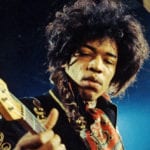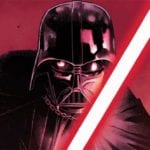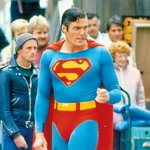 Weird Stuff
Weird Stuff  Weird Stuff
Weird Stuff  Our World
Our World 10 Ways Your Christmas Tree Is More Lit Than You Think
 Movies and TV
Movies and TV The 10 Coolest Stars to Set Sail on The Love Boat
 History
History 10 Things You Didn’t Know About the American National Anthem
 Technology
Technology Top 10 Everyday Tech Buzzwords That Hide a Darker Past
 Humans
Humans 10 Everyday Human Behaviors That Are Actually Survival Instincts
 Animals
Animals 10 Animals That Humiliated and Harmed Historical Leaders
 History
History 10 Most Influential Protests in Modern History
 Creepy
Creepy 10 More Representations of Death from Myth, Legend, and Folktale
 Technology
Technology 10 Scientific Breakthroughs of 2025 That’ll Change Everything
 Weird Stuff
Weird Stuff Ten Bizarre Facts About The Doge Meme
 Our World
Our World 10 Ways Your Christmas Tree Is More Lit Than You Think
 Movies and TV
Movies and TV The 10 Coolest Stars to Set Sail on The Love Boat
Who's Behind Listverse?

Jamie Frater
Head Editor
Jamie founded Listverse due to an insatiable desire to share fascinating, obscure, and bizarre facts. He has been a guest speaker on numerous national radio and television stations and is a five time published author.
More About Us History
History 10 Things You Didn’t Know About the American National Anthem
 Technology
Technology Top 10 Everyday Tech Buzzwords That Hide a Darker Past
 Humans
Humans 10 Everyday Human Behaviors That Are Actually Survival Instincts
 Animals
Animals 10 Animals That Humiliated and Harmed Historical Leaders
 History
History 10 Most Influential Protests in Modern History
 Creepy
Creepy 10 More Representations of Death from Myth, Legend, and Folktale
 Technology
Technology 10 Scientific Breakthroughs of 2025 That’ll Change Everything
11 Iconic Guitar Combinations
It’s said ‘a poor musician blames his instrument’ but what about good musicians? Do they claim their accomplishments are solely the result of their own efforts? Not really. Most of them thank co-writers, band mates, friends and family.
Guitar players, however, are famous for attributing success to a unique bond with their instrument. As a result, man and machine become inseparable, and over time, the general public has trouble separating where the guitar ends and the guitarist begins. Submitted for your approval is a list of several iconic guitar(ist) combinations. And yes, this one goes to eleven.
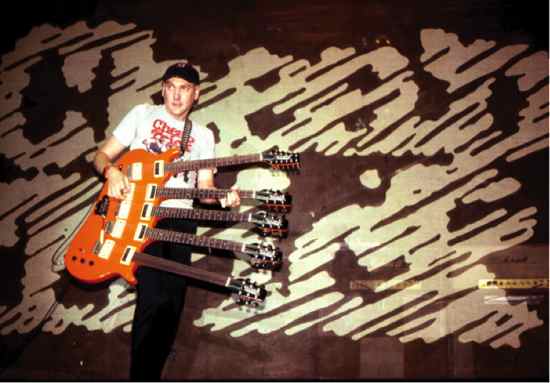
As a boy, Rick Nielsen quit collecting stamps because they weren’t loud enough. Switching to guitars should have slowed him down, but didn’t: he recently pared his vintage guitar collection down to the essentials, and it’s still well north of two hundred instruments.
That’s not counting the dozens of novelty guitars he uses in every Cheap Trick show: he has checkerboard guitars, Beatles guitars, album cover guitars, even a cartoon character guitar that looks exactly like him. So it’s gonna take a special guitar to cement the public image of Rick Nielsen on stage.
Enter the wonderfully stupid Hamer five-neck electric guitar. It hit public consciousness hard in the 1982 ‘She’s Tight’ music video, and Nielsen has been doomed to lug the 80-lb joke on tour ever since. Possibly one of the most-recognized rock instruments ever, the guitar is completely functional, with one 12-string neck, three six-string necks, and a fretless bottom neck (if you can reach it).
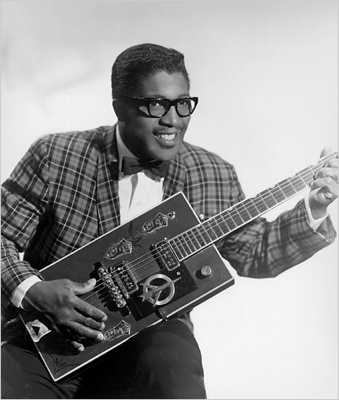
Bo Diddley is, arguably, most responsible for transitioning blues into rock and roll, mainly through his use of insistent, driving rhythms and hard-edged tone. His trademark instrument was a rectangular-bodied electric guitar that he developed himself and played in thousands of concerts. Why a rectangle? Well, it turns out he was jumping around on stage one night, and his massive Gibson L5 shifted and hit him right in the boys. The next day, Bo designed the smaller (safer) guitar we’ll forever associate with him.
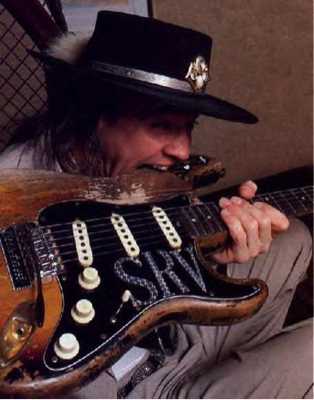
Number One (aka, ‘First Wife’) was a Fender Stratocaster used by Texas blues guitarist Stevie Ray Vaughan. He played it on every one of his studio albums, and in hundreds of concerts. Stevie Ray said he immediately knew there was something special about Number One. He said he didn’t even have to play it—he just knew by the way it looked that it would sound great.
Usually it’s the woman who tries to change the man after marriage. Not with Stevie Ray. Immediately after trading for Number One, he tried to convert it to a left-handed tremolo to imitate his idol, Jimi Hendrix. But the job was botched, and he went to a truck stop desperate for something to cover the damage. All he could find was a “custom” sticker in the parking lot, so he slapped that across the bridge, and added prismatic stickers to spell out his initials, “SRV”. Additional modifications are too numerous to count.
But that’s nothing compared to the legendary abuse that Number One took. Treat a woman like Stevie Ray Vaughan treated a guitar, and you’ll do time. Stories abound about how he would kick it, punch it, ride it like a surfboard, and carry it around by the tremolo bar. And if that wasn’t enough, during shows he’d bounce it off the wall, catch it (or not), and keep on playing.
Number One is currently in the possession of Stevie’s brother, Jimmie Vaughan, although rumors persist that it was buried with Stevie in Dallas.

Much like a cartoon character wears the same clothes in every episode, cartoonish Angus Young is rarely seen in anything but a schoolboy uniform, playing a Gibson SG electric guitar. The look is every bit a trademark as the band’s logo, and has been official AC/DC merchandise for over thirty years.
Young first discovered the SG at 14, when he bought a used 1967 model. It was very light and had an extremely thin neck that suited his smaller hands (he’s 5’3″). This is odd for Gibson products, and many now believe he learned to play on a factory defect or a stolen custom instrument. That guitar lasted only a year, as the neck warped and rotted from Young’s blood and sweat. But by then his fingers could twist into pretzels if called upon, and it’s been nothing but stock SGs after that.
Young has worked with Gibson extensively to try and re-create the specific elements that made that first SG so special, but to no avail. You can however, play a signature model, which re-creates many components of his current touring guitar.
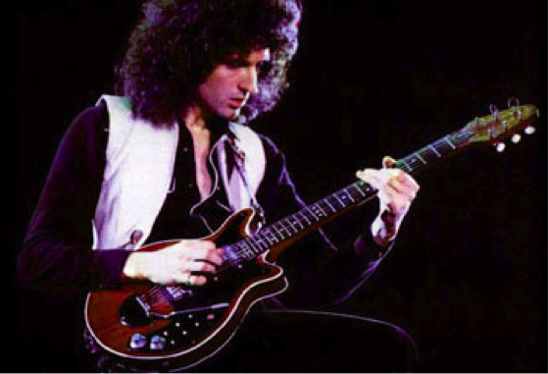
Dr. May (PhD, Astrophysics) built his one-of-a kind electric guitar with his dad over 40 years ago, primarily because they couldn’t afford a ‘proper’ guitar. Father and son designed and built the instrument from scratch, with the goal of producing greater range, tunability, and vibrato than guitars currently on the market. Oh, and it HAD to feed back, which was precisely what Fender and Gibson were trying to avoid with their guitars.
The ‘Red Special’ took two years to complete, and emptied the local junkyard. The neck used wood from a 19th century fireplace mantle, and the tremolo used metal from a motorcycle kickstand and his mother’s knitting needles. The unique red color came from countless applications of Rustin’s Plastic Coat (a furniture finish). The only place young Brian splurged was on the Burns Tri-Sonic pickups, which are responsible for the bright, crunchy tone on Queen’s ‘We Will Rock You’ and the biting solo in ‘Bohemian Rhapsody’.
Numerous companies have made Red Special copies over the years, but now you can get a real one from the man himself at brianmayguitars.co.uk. Just don’t take your motorbike if you pick it up in person—you may be missing some pieces on the ride home.
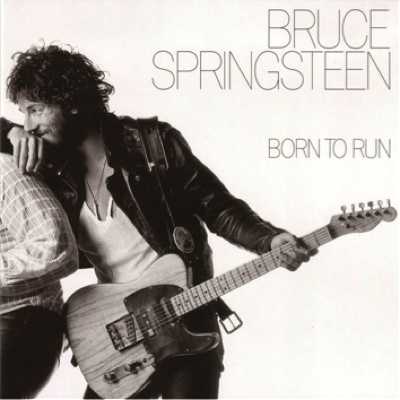
Bruce Springsteen plays other guitars, and keeps plenty of spares on tour, but the Born to Run album cover forever links The Boss to a blackguard, maple-neck Fender Esquire. And he hasn’t fought the perception. Since its debut on BTR in 1975, the guitar has been his virtual co-star, appearing on the covers of Bruce Springsteen & the E Street Band Live 1975-85, Human Touch and Greatest Hits.
Like any legendary instrument, details of its origins are murky. Some say Bruce originally bought it from a luthier who (others say) rescued it from a recording studio liquidation sale. His guitar techs say it’s either a 1953 or ’54 model, or possibly a ’55 due to the v-profile on the neck. It’s been in the shop for more nips and tucks than Joan Rivers, so you’d best go to the Rock and Roll Hall of Fame (where it now resides) to decide for yourself.
As Fender’s mortal enemy Gibson says, ‘Ultimately, who cares…whatever kind of mutt of an instrument the thing had become by the time it landed in Springsteen’s hands, it has been the driving force behind some of the most compelling rock anthems in the last 35 years.”
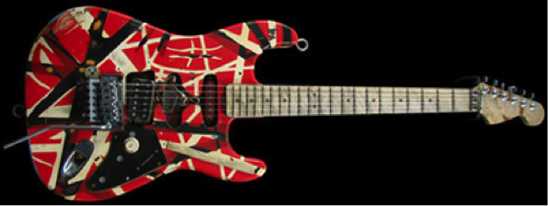
David Lee Roth sent Eddie Van Halen home for bringing a Gibson ES to practice, telling Eddie “you ain’t Roy Orbison, come back with a real guitar”. Eddie tried a Les Paul but it was too heavy, and a Fender Stratocaster sounded too thin. That’s when he got the crazy notion to combine the two. The resulting surgery was a mess, but the butchery was covered by a black pick guard, so no one was the wiser. Well, except for the ‘tone’ knob controlling the volume.
Undeterred, he then used masking techniques to paint the guitar white with random black stripes. It looked pretty awful, but all those electrical mods produced a rich tone known as the ‘brown sound’. The guitar was prominently photographed on the 1979 album Van Halen, which sold gangbusters and made the band an overnight sensation.
Eddie’s popularity spawned loads of copycat guitars, so he painted the Frankenstrat with red bicycle paint, lost the pick guard, and added a nonfunctional pickup near the neck, next to a fake five-way switch. Other changes included a Floyd Rose tremolo shimmed with a 1971 quarter, school bus reflectors on the back, and a smaller pick guard made out of a vinyl record.
And that’s not even half the modifications this poor instrument has endured. But the guitar is now as unique to Eddie as his fingerprint, and the band did go on to sell over 50 million records with it. A 2008 version of the Frankenstrat now resides in the Smithsonian Institution.
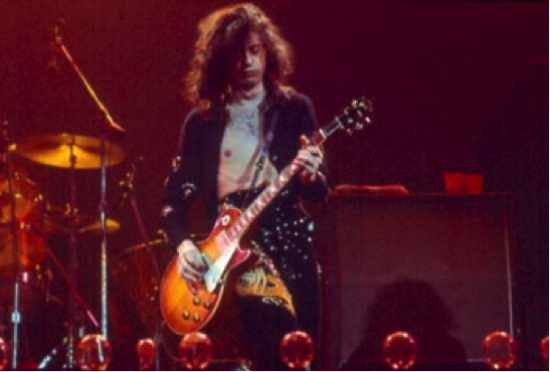
Guitarists buy Les Pauls because they think playing one on stage will get them laid. They’re right. And much of the thanks goes directly to Jimmy Page, who made this guitar—and Led Zeppelin—the sweaty embodiment of 70’s sex, drugs and rock’n’roll.
Case in point: Black Dog.
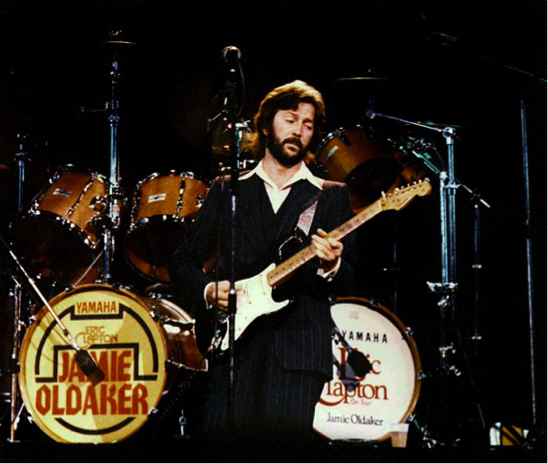
In the late 60s Eric Clapton was at a career crossroads. On pure impulse, he bought six Fender Stratocasters from a Nashville music store, despite being a devoted Gibson player. He gave one guitar each to friends George Harrison, Pete Townsend, and Steve Winwood, and then used the best components of the remaining three to make a single guitar for himself.
Little did he know that instrument would become his stage and studio guitar for the next 15 years. Clapton nicknamed the guitar ‘Blackie’ and played it on thirteen consecutive solo albums, including 461 Ocean Boulevard (“I Shot the Sheriff’) and Slowhand (“Wonderful Tonight”, “Lay Down Sally”, and “Cocaine”).
Blackie’s last public appearance before retirement was the Live Aid concert for Africa in 1985. In 2004, Clapton auctioned off Blackie and donated the proceeds to the Crossroads Centre, a drug and alcohol rehab clinic on the Caribbean island of Antigua. American music chain Guitar Center purchased Blackie for $959,500, which was a world record at the time. Guitar Center technicians say the instrument is in working order, and if it goes missing, the first place they’ll look is Clapton’s house.
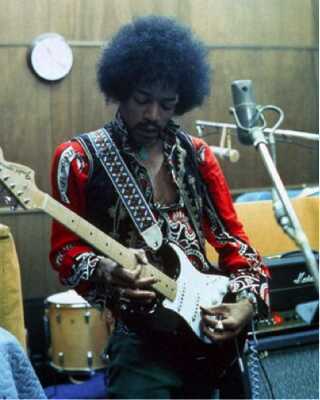
In the 1960s, seeing a black man with a foot-wide afro dressed like a pimp and playing rock guitar backwards must have been mind-blowing, drugs or no drugs. Add that said music was 20 years ahead of its time, and it’s almost too much too take. Such was Jimi Hendrix.
Yeah, it is rumored that Jimi preferred the darker tone of Les Pauls right before he set the standard for rock star deaths. But Hendrix will forever be remembered for playing reverse-strung, right-handed Fender Stratocasters left-handed. Don’t bother re-reading that—it doesn’t help, and yeah, it was just as weird to write as it was to read.
And note the plural. Jimi isn’t linked to a single guitar because he had this insane penchant for lighting the damn things on fire during performances. As a result, the few remaining Hendrix Strats are worth a small fortune. In 2008, a guitar Hendrix torched during a London show sold for £280,000 at auction.

No guitarist is more wedded to his instrument than the reigning Monarch of the Blues, B.B. King. As the man himself tells it, in 1949 he was playing a ‘Chitlin Circuit’ dancehall in Arkansas when the heater upended and set the building on fire. In his haste to escape the flames, King left his beloved Gibson semi-hollow electric guitar inside.
Mortified at his potential loss, King ran back into the burning building and retrieved it. The next day he learned the fire was started by two men fighting over a woman named Lucille, so he named the guitar ‘Lucille’ to remember those mad moments when he risked his life to save it. He then vowed never again to run into a burning building or fight over women (some will argue these are two separate things, but they don’t understand the blues).
In 1968 King described Lucille with equal parts sacred devotion and dirty passion: “it loves to be petted and played with. There’s also a certain way you hold it, the certain noises it makes, the way it excites me … and Lucille don’t want to play anything but the blues … Lucille is real, when I play her it’s almost like hearing words, and of course, naturally I hear cries.”
